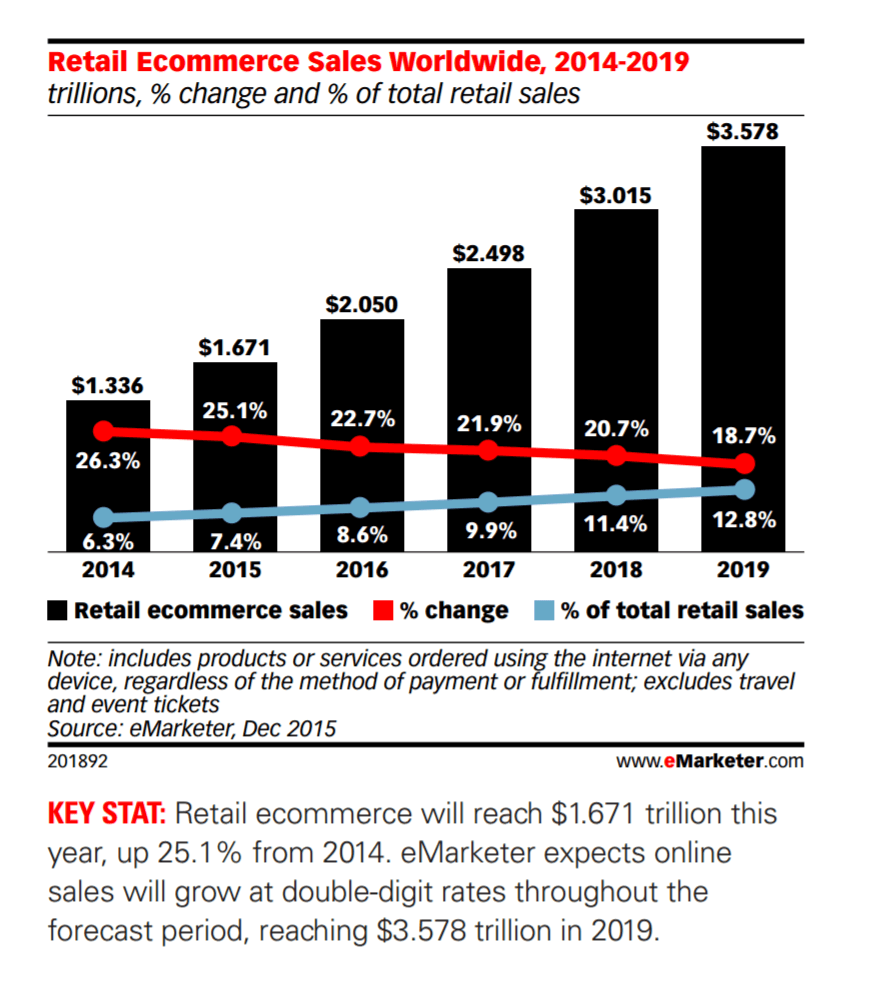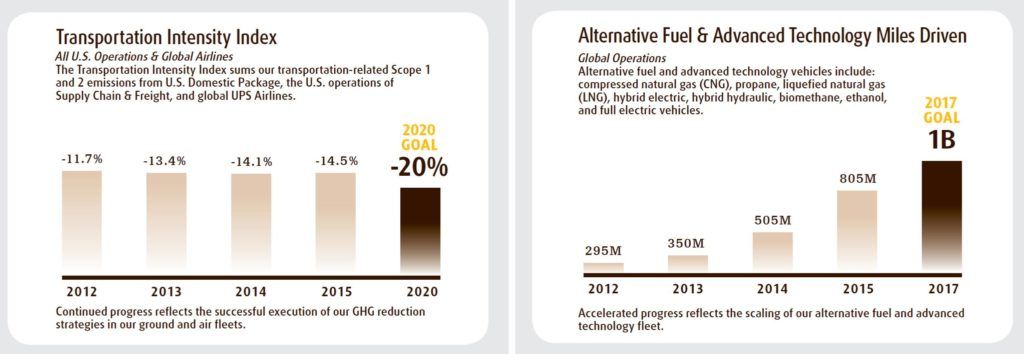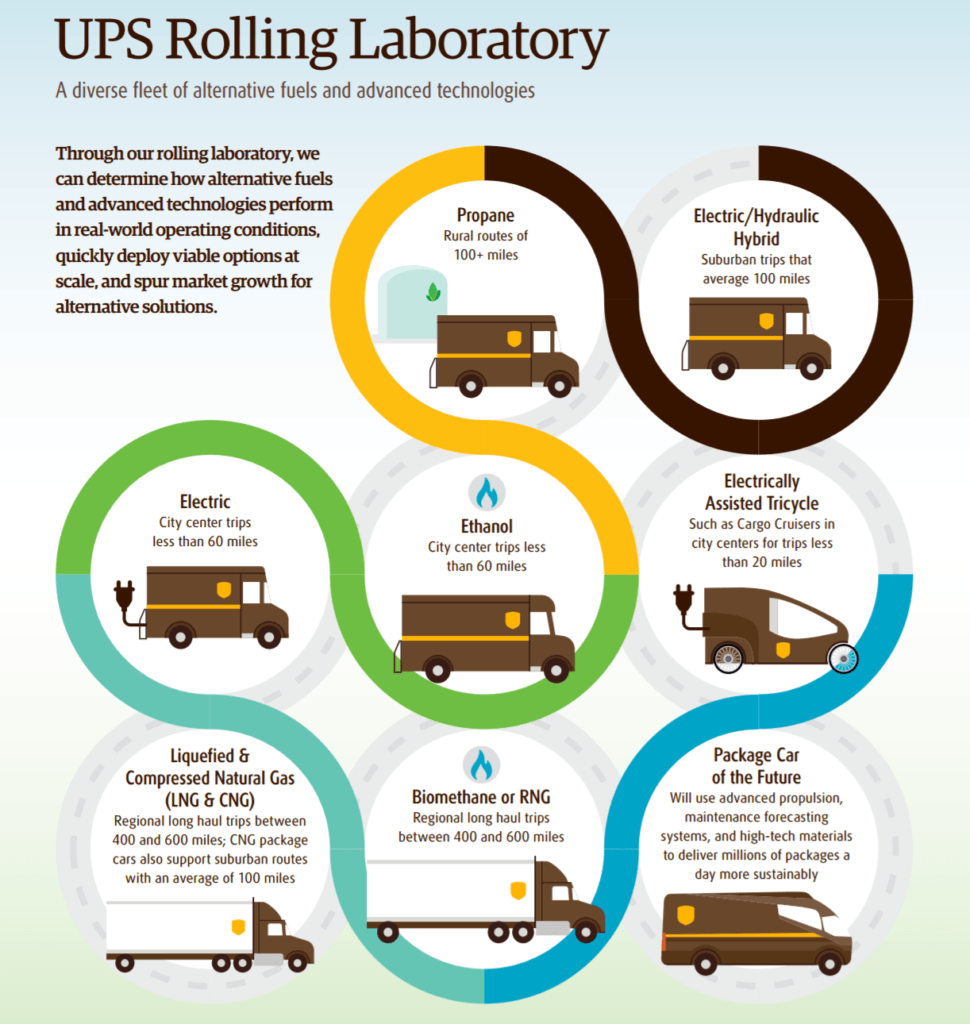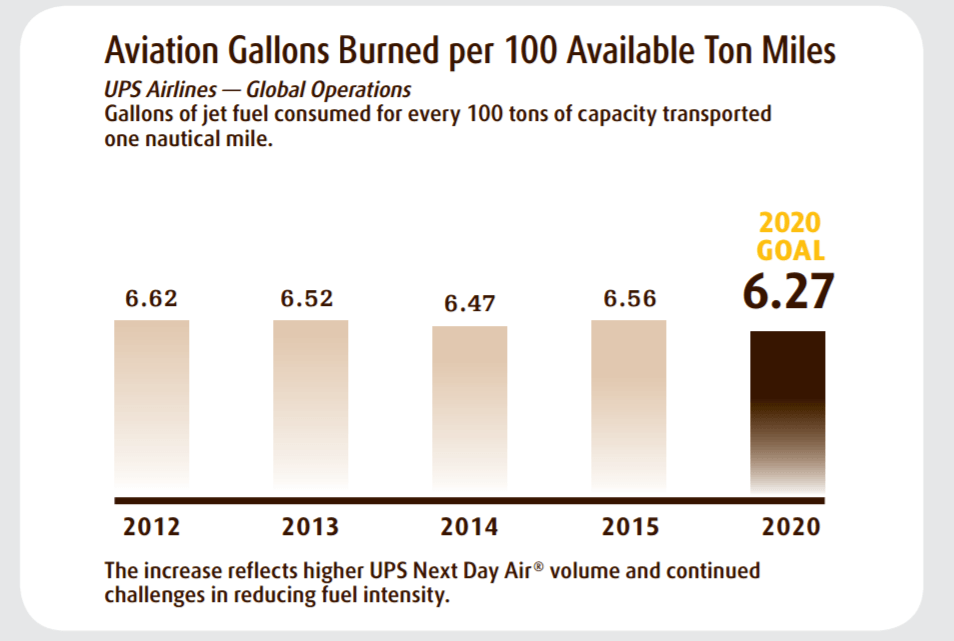UPS: United Problem Solvers or United Petroleum Supporters?

Does UPS’ current model of business inherently conflict with its sustainability goals?
There may be a contingent of people in the world that deny the existence of global warming, but I think you’d be hard-pressed to find a group of people who reject the assertion that e-commerce has experienced significant growth over the past decade. If you do come across such a group however, feel free to show them the following chart [1].
While e-commerce companies have certainly benefited from the shift in consumer behavior to online shopping, so too have transportation and logistics companies, like UPS, that are responsible for delivering the products to the consumers that order them. Although the increased deliveries from e-commerce sales certainly drive revenue growth for UPS (daily package volume increased 5.7% in the three months ending on 9/30/2016)[2], these deliveries disproportionately contribute to the company’s total emissions output, as they require more stops with fewer packages being delivered at each stop.
As the world’s largest package delivery company and a provider of supply chain management solutions, UPS consumes a large amount of energy, primarily in the form of fossil fuels, to keeps its operations running. The burning of fossil fuels generates greenhouse gas emissions (GHG) which traps energy in the atmosphere causing temperatures on earth to rise [3]. As the subject of climate change has come to the forefront of public conversation, UPS has taken a multi-pronged approach to reduce its overall emissions and impact on climate change [4].
Internal Emission Reduction Measures
UPS has committed to reducing its carbon intensity by 20% by 2020, and the company is well on its way to meeting this goal having already achieved a 14.5% reduction since 2012. UPS has employed two primary tactics to drive this change: reducing the total amount of fuel required to make deliveries by reducing the total miles traveled and improving fuel efficiency and increasing the use of alternative energy sources to replace traditional petroleum. Thus far, 70% of ground delivery routes in the US have been equipped with the On-Road Integrated Optimization and Navigation (ORION) system which provides optimized delivery routes from a distance, fuel, and time perspective to UPS drivers. The ORION system will be fully deployed by the end of 2016, and the company expects it to reduce miles driven by 100M miles per year.
Additionally, in order to accelerate the introduction of alternative energy sources in its vehicles, UPS has created a rolling laboratory to determine how alternative fuels and advanced technologies perform in real-world operating conditions. The company has been able to replace the conventional diesel and gasoline fuel with alternative fuels like renewable natural gas and renewable diesel fuel.
Customer Facing Emission Reduction Measures
UPS has also developed ways to involve its customers in helping to achieve its emissions reduction goals. UPS MyChoice® allows consumers to choose a specific date and time to receive packages and UPS AccessPoint™ provides a consolidated delivery location where customers can retrieve their packages. Both of these initiatives reduce emissions by eliminating mileage associated with missed delivery and pickup attempts. Additionally, UPS’ Carbon Neutral Shipping Program enables customers to neutralize the emissions associated with their shipments by purchasing carbon offsets. On the supplier side, UPS has implemented dimensional weight pricing in which the price to ship a package is based on the amount of space the package takes up in relation to its weight rather than just the package’s weight. This pricing scheme encourages companies to ship their products in size-appropriate boxes.
An Eye Toward the Future
As the effects of climate change continue to be widely publicized, and as governments begin to impose more stringent emissions regulations, UPS will need to continue to engage in actions aimed at reducing the company’s emissions of greenhouse gasses (GHG). Thus far, the company’s efforts have been primarily focused on reducing emissions within its ground transportation fleet due to the lack of financially viable/commercially available renewable sources of aircraft fuel. This has created a challenge for the company, as UPS Airlines currently accounts for 57% of UPS’ total GHG emissions, and deliveries that require airplane transportation continue to become a larger share of UPS’ total package deliveries.
Although viable commercial production of renewable fuel for airplanes is still a few years away, as a leader in the industry, I believe that UPS should actively participate and invest in the development of such solutions. United Airlines recently announced an effort to introduce aviation biofuel into its regular operations [5], and there is no reason why UPS can’t lead this charge as well. In the short term, the company might need to forgo some profits due to higher input costs, but in the end, the investment in sustainable sources of aircraft fuel is sure to pay off. If you were in David P. Abney, the CEO of UPS’ shoes, what would you do? (793 Words)
[1] “Worldwide Retail Ecommerce Sales: eMarketer’s updated estimates and forecast through 2019.” eMarketer. http://www.emarketer.com/public_media/docs/eMarketer_eTailWest2016_Worldwide_ECommerce_Report.pdf
[2] “UPS expects holiday package volume to grow more than 16%.” Internet Retailer. https://www.internetretailer.com/2016/10/27/ups-expects-holiday-package-volume-grow-more-16.
[3] “Causes of Climate Change.” https://www.epa.gov/climate-change-science/causes-climate-change.
[4] “UPS Committed to More™ 2015 Corporate Sustainability Report.” UPS. https://sustainability.ups.com/media/2015_UPS_CSR.pd.
[5] “United Airlines Describes Effort To Introduce Aviation Biofuels.” AIN Online. https://www.ainonline.com/aviation-news/air-transport/2016-11-01/united-airlines-describes-effort-introduce-aviation-biofuels.







Interesting! USPS also has various interesting initiatives such as encouraging customers to recycle more: http://about.usps.com/what-we-are-doing/green/maxback.htm
I also think younger companies such as Avrios fleet management (http://www.avrios.com) are providing interesting tools to align sustainability with cost saving.
I completely agree with your points above, and I do think that UPS should be actively involved in finding sustainable solutions for its air transport. That being said, I find it difficult to pinpoint who should carry the weight of the cost of investing in sustainable aircraft fuel. UPS can take on higher input costs in the short-run, but given that the e-commerce sales are forecasted to continue on an upwards trend over the next 5+ years, the input costs for UPS will potentially continue to rise. From a business perspective, I’m not sure it makes sense for UPS to continue footing the bill indefinitely – the customer should take on more of the shipping cost. However, this may have serious ramifications on UPS’ overall business volume, as customers seek alternative shipping providers (i.e. FedEx / DHL) or, in Amazon’s case (a company that contributes $1bn to UPS’ business), take on shipping in-house (http://www.wsj.com/articles/amazons-newest-ambitioncompeting-directly-with-ups-and-fedex-1474994758).
If I was David P. Abney, I would start to look into ways that I can physically start to remove vehicles from the road. I would think of taking a page out of Uber’s book and look to create a more structured version of UberRUSH. This ability to leverage vehicles that are already on the road to do on-demand one way trips could do a great deal to mitigate emissions while the company continues to implement and innovate around alternative fuels. In addition to this potential solution, UPS should also be investing in drone technology. This type of innovation has the potential to be a patch solution until greener jet fuel can be developed. Given that it is impossible to close Pandora’s Box of online purchasing and overnight delivery, UPS absolutely needs to investigate every option to operate in a more sustainable way.
It’s interesting to read about all the initiatives UPS is taking to go green. With the steep growth in e-commerce, and expansion of the delivery coverage areas, it could really be a game changer for them with technology like drones and self driving vehicles. But before that’s coming, how to best utilize resources and lower per parcel per distance cost could also be optimized with advanced algorithms and data science.
Great post about the different sustainability measures UPS is implementing! I’m impressed by the impact the steps they have already taken are having. For example, it’s remarkable that UPS will be able to reduce miles driven by 100M per year simply through an optimized navigation and logistics software. It makes me wonder if they can do even more to optimize their network and reduce their environmental impact. Currently, UPS My Choice and delivery through access points is an opt-in program. What if they switched it so that consumers had to opt out to have their packages delivered to their door? I also wonder if they could do more to optimize their loads so that drivers didn’t spend too much time driving with nearly empty trucks. In addition to dropping off packages, could UPS have drivers pick up additional packages along the way? As with airlines conducting linear routes, it may result in a higher utilization of its vehicles.
Wow!
As I continued to read these articles on companies which are taking steps towards “band-aid” solutions to the Climate Change problem, it is refreshing to see that UPS is taking a more serious approach. In particular, it’s interesting to see that UPS has implemented a logistics, technologically enhanced solution to better operations. As business school students it’s valuable to understand that it is indeed possible to use pragmatic green initiatives in order to inspire the consumer. As consistent e-commerce shoppers, our generation must continue to support programs such as “my choice”. This is beneficial not only to us as consumers, but also to our one and only planet.
I am glad UPS is taking steps, but this “all of the above” approach worries me. Opening a lab to investigate alternative fuels is not a smart use of capital; other companies (like Tesla) already have done all the research and are already building solutions. I think UPS should instead partner with a company to build an electric version of their trucks.
According to this Quora post (https://www.quora.com/How-many-miles-per-day-does-a-FedEx-or-UPS-driver-drive-on-average), the average route is about 160 miles a day. Let’s be conservative and say 300 miles a day. Both of Tesla’s car models can do that already!
UPS could convert their trucks to electric, put in a few more batteries than in current Teslas (say, 100% more), and charge their trucks overnight. There is no need to even worry about fast charging.
Tesla is already designing a Semi truck. The tech is there. Companies like UPS need to stop creating “labs” and “research centers” and work with the viable solutions that already exist.
PS we are closer to electric planes than you may think! http://qz.com/611677/elon-musk-is-thinking-about-building-an-electric-airplane-that-takes-off-vertically/
UPS is a very interesting case with respect to climate change. I found it interesting that UPS was so forward thinking in fueling its ground transportation with renewable energy sources, but I would like to know more from them. What percentage of their fleet is using less harmful fuel types and what is their projected timeline to transition their fleet to a renewable energy source. This article also made me think about the use of drones and whether UPS has considered exploring their use. I wonder how drones compare to UPS trucks in terms of energy efficiency.